The Gaynarja mud volcano is located in the Pre-Caspian-Guba geological region (Fig. 1). From the tectonic point of view, the volcano is part of the Telebi-Gyzylburun anticline zone, but geomorphologically, it is located the in the Gusar-Khachmaz Pre-mountain area.
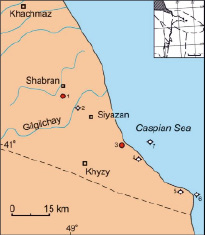
Fig. 1. Location map of mud volcanoes in the Pre-Caspian-Guba region [1]. 1 – Gaynarja; 2 – Saadan; 3 – Khydyrzinde; 4 – Zarat; 5 – Shuraabat; 6 – Yashma; 7 – Zarat-deniz
The volcanic landscape is complicated by the presence of ravines, river valley, volcanic cones (spokas) and gryphons. Along the arch of Gaynarja fold is tracked a lengthwise fault of which amplitude is 150–200 m. Related to the fault, there are several gryphones, sopkas and salses that emitt gas, water and slimy mud from the Earth’s deepth to the surface (Fig. 2). The mud volcano differs from other mud volcanoes in the Pre-Caspian-Guba region in Azerbaijan with its relative size, the daily activity of gryphons and salses.
Administratively, the Gaynarja mud volcano has found its development 8-10 km to the south-west of the center of Shabran district, as well as near the Tahtakorpu Water Reservoir (TWR).
The TWR construction began in 2007 and is used since September 28, 2013. The Reservoir area is 8.71 km2. Total water capacity is 270 million m3. The width of the hydraulic construction from the bottom is 754 m, the height is 142.5 m.The Reservoir belongs to the Samur-Absheron irrigation system.
Since Azerbaijan is the land of mud volcanoes in the world, 3–4 eruptions of mud volcanoes occur on the country territories in every year. In addition, there are many mud volcanoes in the country that have daily activity. As a result of eruption and daily activity, products with different phase eject to the Earth’s surface from the various depths [2–9]. These products are consist of different genetic types of waters with a high degree of mineralization, gases which mainly consisting of CH4, CO2, H2S, as well as breccias containing radionuclides and heavy toxic metals. Sometimes the concentration of several elements trace in volcanic products exceed their normal distribution in sedimentary rocks, waters, etc. Such periodic activity of volcanoes leads to the covering of volcanic products in the large areas and causes the formation of unique landscapes that harm for ecosystems.
In addition to the mentioned problem, there is one more serious factor related to the anthropogenic impacts to mud volcanoes in Azerbaijan. There are mud volcanoes in which craters and nearby areas have been constructing industrial facilities.
The presented research is intended to the study of ecogeological risks connected with activity of mud volcanoes and anthropogenic influences on the example of the Gaynarja mud volcano and TWR.
Materials and methods of research
Related to the goal of the investigation, some visual, satellite, geological, geochemical and radioactive researches were conducted at the Institutes of Geology and Geophysics and Radiation Problems, Azerbaijan National Academy of Sciences.
The analysis were carried out in gas chromatography to determine the chemical composition of gases in 3 gas and 2 water samples. The amount of organic matter was studied in 3 rocks and 2 water samples. The organic composition of rocks was determined by the performed pyrolysis in two stages.
Elemental analysis were studied in 3 water and 2 rocks samples with Atomic Absorption Spectrometer “200 Agilent” and S8 TIGER – High-end wavelength dispersive X-ray fluorescence (EDXRF) spectrometer.
Radiometric studies were conducted to study the distribution of background radiation on the territory of the mud volcano. The measurements were carried out by radiometers such as “CPP-88M” and “InSpector-1000”, which provide measurement of the exposure dose rate of gamma radiation in the range of 0-5000 microR/h.
To study the nature of the radioactivity anomalous, 4 rocks and 3 water samples were collected for gamma spectrometric analysis.
Results of research and their discussion
Since 2007 to the present day the TWR water area has been expanding without regard to keep the necessary distance from the mud volcano (Fig. 3, a, b and c). The building area covers the most parts of the volcanic crater (Fig. 3, c). Associated with this, mud volcanic products are buried beneath the Reservoir water.
The carried out researches confirm that any construction and engineering work in the territories and nearby areas influence their activation [1, 13]. In addition, the mud volcano is located near the Shamakhi-Ismayilli active seismic zone in Azerbaijan. Both factors increase the risk of eruption of the mud volcano [10–13]. On the other hand, the eruption of these mud volcanoes poses a danger to both infrastructures (existing in nearby areas) and the biosphere. Therefore, specialists are considered that depending on the degree of volcanic activity, these works should be carried out at appropriate distances with mud volcanoes.
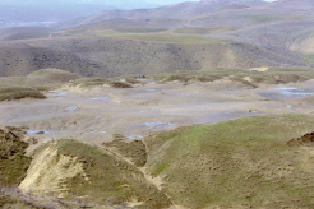
Fig. 2. Crater area of the Gaynarja mud volcano
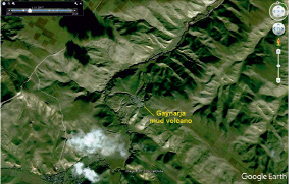
a)
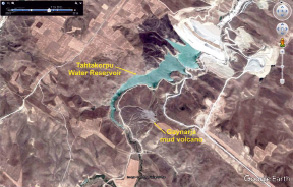
b)
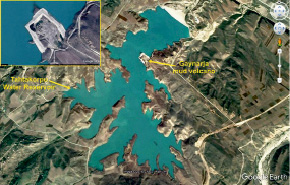
c)
Fig. 3. Satellite images of the Gaynarja mud volcano: a) 2007 year, b) 2011 year, c) 2017 year
Gases in the mud volcanoes of Azerbaijan mainly contain CH4 85–98 % [1]. The gas composition of the Gaynarja mud volcano consists of CH4 (87–94.0 %), CO2 (1,1–5,9 %) and N2 (1,2–9,3 %). The amount of gas components in water samples (sapmled from the salses): CH4 – 0.00002-0.00126 %; CO2 – 0.01963-0.91287 %; H2S – 0.00066–0.00175 %.
Compared to other waters in the region, waters of the Gaynarja mud volcano (emmited to the Earth’s surface) are too mineralized (average of 244 mg/eq), and they are hard and chloride-sodium-calcium type waters. The water of one salsa located in the southeast region is very salty (655 mg/eq.).
In water samples: H2CO3 varies from 421.6 mg/l to 526.3 mg/l; C6H5OH from < 0.001 to 0.0038 mg/l; N from 12.6–37.5 mg/l. Total amount of organic matter ranges from 0.22 to 21.8 mg/l.
Mud volcanoes are mainly located in oil and gas regions in the Rebublic. Eruption of mud volcanoes results with the releasing of volcanic products from the depth of 6-9 km or more, among which oil shale and oil-bearing rocks are traced [1–9]. Age of the oil shales is Paleogene-Miocene and they are very rich with organic matter [14–19]. Laboratory analysis of these rocks gives a positive results for their organic chemistry composition [18–29].
Thus, such oil shales were geochemically analyzed in the study.The amount of organic matter in the oil shale rocks ranges from 9.5 to 12.65 %. It was determined that there was no oil in the rock composition. The amount of gas composition varries from 2.43 to 5.24 % at a temperature of up to 500-550 °C. Increasing the temperature to 800-850 °C lead to the reduction of gases (1.20–2.67 %). Thus, the analysis of organic chemistry of volcanic rocks by the method of pyrolysis shows that the organic mattre in the composition of rocks basically consists of gases and koks (Table 1).
Most of the elements (Hg, As, Mo, Co, Zn, Pb, P, etc.) were identified in volcanic breccia and water. Some of them are traced with high amount (more than for their normal concentration in the sediments and waters) in volcanic breccia. Forexample Hg: 0.0000031-0.0000042 %, As: 0.0003-0.0004.1 %, Sr: 0.0462–0.0487 %; Pb 0.0021–0.0043 %. The results of elemental analysis of water samples from the Gaynarja mud volcano are shown in the Table 2.
Radiometric measurements were carried out on 6 profiles crossing the mud volcanic field and oriented along the SE-SW and SW-SW directions. The radioactivity of breccias in the mud volcano varies widely – from 9.5 mR/h to 23 mcR/h. Relatively high values of radioactivity are traced in the central, northern and northeastern parts of the volcano (Fig. 3).
To study the nature of the radioactivity anomalous, the breccia samples were collcected both from points with relatively high and low radioactivity. The analysis results are shown in Table 3. The breccia activity in the mud volcano varies in wide range – from 106.4 to 515.12 Bq/kg. It reflects the overall level of integral gamma radiation, depening on the composition and content of radionuclides present in the rocks. In the samples 1 and 4, gamma radiation level is basicly depends on uranium (U) series elements. The amount of thorium (Th) does not exceed Clark, and potassium (K) is always present in rocks of mud volcanoes.
Table 1
Two-stage pyrolysis of rock samples from Gaynarja mud volcano
|
Sample |
Organic matter, % |
500–550 °C |
800–850 °C |
||
|
Oil |
Gas |
Oil |
Gas |
||
|
1 |
12,2 |
– |
2,34 |
– |
2,67 |
|
2 |
12,65 |
– |
4,99 |
– |
1,88 |
|
3 |
9,5 |
– |
5,24 |
– |
1,20 |
Table 2
Elemental composition of water samples from Gaynarja mud volcano, mg/l
|
Sample |
Hg |
Pb |
Zn |
P |
|
1 |
0,0018 |
0,042 |
0,2 |
0,0002 |
|
2 |
0,0014 |
0,034 |
0,8 |
0,0016 |
|
3 |
0,0011 |
0,048 |
0,6 |
0,0002 |
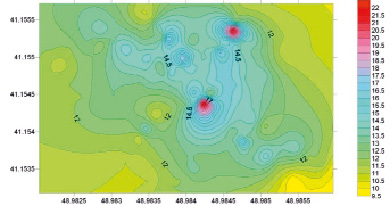
Fig. 3. Distribution map of radioactivity in the crater zones of Gaynarja mud volcano
Table 3
Specific activity and content of radionuclides in the breccia samples of the Gaynarja mud volcano
|
Samples |
Integral radioactivity, microR/h |
Activity, Bq/kg |
U, Bq/kg |
Th, Bq/kg |
К, Bq/kg |
|
1 |
23 |
481,56 |
431,81 |
– |
634,61 |
|
2 |
14–15 |
106,4 |
50,19 |
0,45 |
704,87 |
|
3 |
16–17 |
118,51 |
12,15 |
77,99 |
208,42 |
|
4 |
23 |
515,12 |
480,15 |
– |
671,71 |
Table 4
The content of radionuclides in the water samples from the salsas of Gaynarja mud volcano
|
Radionuclide |
Sample – 1 |
Sample – 2 |
Sample – 3 |
Norm for drinking water, Bk/L |
|
K 40, Bk/L |
25,6 ± 4,2 |
15,2 ± 1,4 |
16,6 ± 1,9 |
22,0 |
|
Ra 226, Bk/L |
0,228 ± 0,054 |
0,154 ± 0,024 |
0,126 ± 0,028 |
0,5 |
|
Ra 228, Bk/L |
0,138 ± 0,010 |
0,324 ± 0,050 |
0,644 ± 0,036 |
0,2 |
|
Rn 222, Bk/L |
0,20 ± 0,12 |
0,18 ± 0,10 |
0,10 ± 0,06 |
120,0 |
|
U 235, Bk/L |
0,0144 ± 0,0032 |
0,0064 ± 0,001 |
0,0120 ± 0,0016 |
3,0 |
|
U 238, Bk/L |
0,312 ± 0,069 |
0,139 ± 0,021 |
0,261 ± 0,034 |
3,1 |
The water samples from salsas were also collected to determine the radionuclide composition. The concentration of radionuclides K40 in sample – 1, and Ra 228 in samples – 2 and 3 exceed the maximum allowable concentration of radionuclides in drinking water (Table 4).
Relatively high radioactivity probably associated with a tectonic fault zones, on which located active salses that release fluids with an elevated radionuclide content (samples 1 and 4, Table 3), that was also confirmed in the laboratory studies results (sample 1–3, Table 4).
Conclusions
The studies results make possible to think about the risk factor probability on several aspects:
Since 2007 to the present day, the Reservoir water area has been expanding without regard to keep the necessary distance from the mud volcano. The reservoir covers a lager part of the volcanic crater, and this factor causes contact of volcanic products and water. The carried out researches confirm that any construction and engineering work in the territories and nearby areas of mud volcanic structure influence their activation. In addition, the mud volcano is located near the Shamakhi-Ismayilli active seismic zone in Azerbaijan. Both factors increase the mud volcano eruption risk. On the other hand, the mud volcano probabaly eruption poses a danger to both infrastructures existing in volcanic areas and the biosphere.
Due to the mud volcano daily activity, heavy toxic metals, gases, radioactive elements and etc. have been ejecting to the Earth’s surface in the compositions of volcanic products and it causes direct contact of these and water. Thus, this factor represent a different kind of danger to the environment and hygiene.
Expansion the Reservoir area and water volume leads to increase in additional geostatistical pressure in volcanic area. In addition, the mud volcano is located near the Shamakhi-Ismayilli active seismic zone in Azerbaijan. Both factors increase the mud volcano eruption risk.
This work was supported by the Science Development Foundation under the President of the Republic of Azerbaijan – EIF/GAM-2-2013-2(8)-25/15/4.

